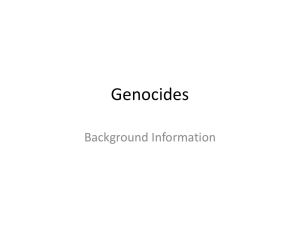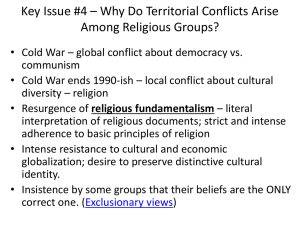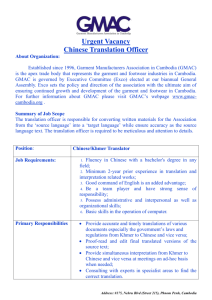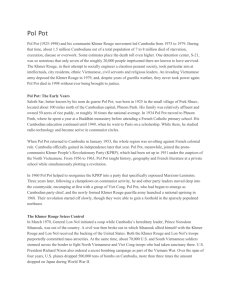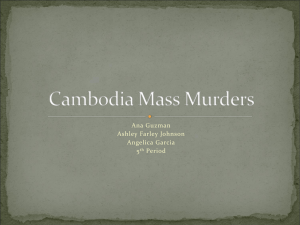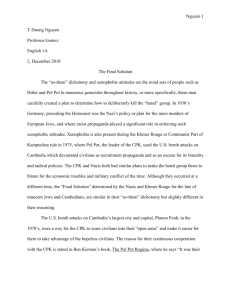khmer rouge history
advertisement
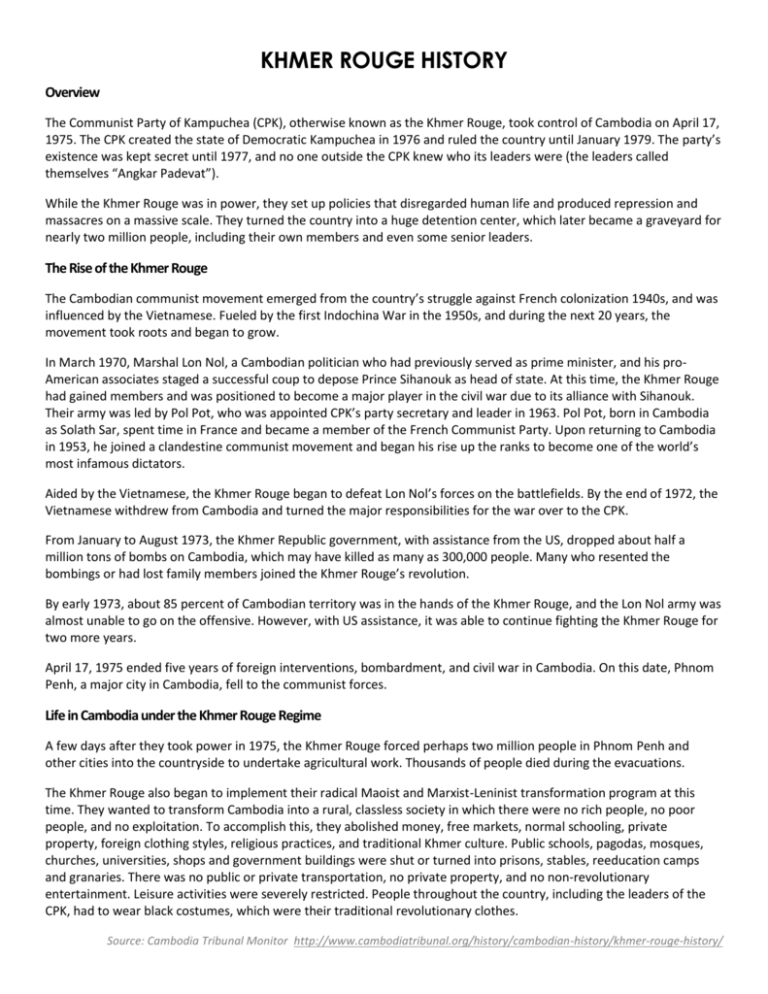
KHMER ROUGE HISTORY Overview The Communist Party of Kampuchea (CPK), otherwise known as the Khmer Rouge, took control of Cambodia on April 17, 1975. The CPK created the state of Democratic Kampuchea in 1976 and ruled the country until January 1979. The party’s existence was kept secret until 1977, and no one outside the CPK knew who its leaders were (the leaders called themselves “Angkar Padevat”). While the Khmer Rouge was in power, they set up policies that disregarded human life and produced repression and massacres on a massive scale. They turned the country into a huge detention center, which later became a graveyard for nearly two million people, including their own members and even some senior leaders. The Rise of the Khmer Rouge The Cambodian communist movement emerged from the country’s struggle against French colonization 1940s, and was influenced by the Vietnamese. Fueled by the first Indochina War in the 1950s, and during the next 20 years, the movement took roots and began to grow. In March 1970, Marshal Lon Nol, a Cambodian politician who had previously served as prime minister, and his proAmerican associates staged a successful coup to depose Prince Sihanouk as head of state. At this time, the Khmer Rouge had gained members and was positioned to become a major player in the civil war due to its alliance with Sihanouk. Their army was led by Pol Pot, who was appointed CPK’s party secretary and leader in 1963. Pol Pot, born in Cambodia as Solath Sar, spent time in France and became a member of the French Communist Party. Upon returning to Cambodia in 1953, he joined a clandestine communist movement and began his rise up the ranks to become one of the world’s most infamous dictators. Aided by the Vietnamese, the Khmer Rouge began to defeat Lon Nol’s forces on the battlefields. By the end of 1972, the Vietnamese withdrew from Cambodia and turned the major responsibilities for the war over to the CPK. From January to August 1973, the Khmer Republic government, with assistance from the US, dropped about half a million tons of bombs on Cambodia, which may have killed as many as 300,000 people. Many who resented the bombings or had lost family members joined the Khmer Rouge’s revolution. By early 1973, about 85 percent of Cambodian territory was in the hands of the Khmer Rouge, and the Lon Nol army was almost unable to go on the offensive. However, with US assistance, it was able to continue fighting the Khmer Rouge for two more years. April 17, 1975 ended five years of foreign interventions, bombardment, and civil war in Cambodia. On this date, Phnom Penh, a major city in Cambodia, fell to the communist forces. Life in Cambodia under the Khmer Rouge Regime A few days after they took power in 1975, the Khmer Rouge forced perhaps two million people in Phnom Penh and other cities into the countryside to undertake agricultural work. Thousands of people died during the evacuations. The Khmer Rouge also began to implement their radical Maoist and Marxist-Leninist transformation program at this time. They wanted to transform Cambodia into a rural, classless society in which there were no rich people, no poor people, and no exploitation. To accomplish this, they abolished money, free markets, normal schooling, private property, foreign clothing styles, religious practices, and traditional Khmer culture. Public schools, pagodas, mosques, churches, universities, shops and government buildings were shut or turned into prisons, stables, reeducation camps and granaries. There was no public or private transportation, no private property, and no non-revolutionary entertainment. Leisure activities were severely restricted. People throughout the country, including the leaders of the CPK, had to wear black costumes, which were their traditional revolutionary clothes. Source: Cambodia Tribunal Monitor http://www.cambodiatribunal.org/history/cambodian-history/khmer-rouge-history/ During this time, everyone was deprived of their basic rights. People were not allowed to go outside their cooperative. The regime would not allow anyone to gather and hold discussions. If three people gathered and talked, they could be accused of being enemies and arrested or executed. Family relationships were also heavily criticized. People were forbidden to show even the slightest affection, humor or pity. The Khmer Rouge asked all Cambodians to believe, obey and respect only Angkar Padevat, which was to be everyone’s “mother and father.” Cambodian refugee children, who fled with their families after Khmer Rouge raids, wait for food at a relief organization's station northwest of Phnom Penh A Cambodian soldier holds a .45 to the head of a Khmer Rouge suspect in 1973. When Sihanouk was forced out of power in a coup, the new Prime Minister, General Lon Nol, sent the army to fight the North Vietnamese and the Khmer Rouge in Cambodia. Fighting two enemies proved to be too much for Cambodia's army. As Civil War raged from 1970 to 1975, the army gradually lost territory as Khmer Rouge increased its control in the countryside. The Khmer Rouge claimed that only pure people were qualified to build the revolution. Soon after seizing power, they arrested and killed thousands of soldiers, military officers and civil servants from the Khmer Republic regime led by Marshal Lon Nol, whom they did not regard as “pure.” Over the next three years, they executed hundreds of thousands of intellectuals; city residents; minority people such as the Cham, Vietnamese and Chinese; and many of their own soldiers and party members, who were accused of being traitors. Anyone thought to be an intellectual of any sort was killed. Often people were condemned for wearing glasses or knowing a foreign language. Hundreds of thousands of the educated middle-classes were tortured and executed in special centers. Many were held in prisons, where they were detained, interrogated, tortured and executed. The most important prison in Cambodia was known as S21,. Only about 12 survived of an estimated 17,000 men, women, and children imprisoned there during the war. Under the terms of the CPK’s 1976 “Four-Year Plan,” Cambodians were expected to produce three tons of rice per hectare throughout the country. This meant that people had to grow and harvest rice all 12 months of the year. In most regions, the Khmer Rouge forced people to work more than 12 hours a day without rest or adequate food. Hundreds of thousands died from disease, starvation, or exhaustion as members of the Khmer Rouge – often teenagers themselves – forced people to do back-breaking work. Fall of the Khmer Rouge By the end of 1977, clashes broke out between Cambodia and Vietnam. Tens of thousands of people were sent to fight and thousands were killed. In December 1978, Vietnamese troops fought their way into Cambodia. They captured Phnom Penh on January 7, 1979. The Khmer Rouge leaders then fled to the west and reestablished their forces in Thai territory, aided by China and Thailand. The United Nations voted to give the resistance movement against communists, which included the Khmer Source: Cambodia Tribunal Monitor http://www.cambodiatribunal.org/history/cambodian-history/khmer-rouge-history/ Rouge, a seat in its General Assembly. From 1979 to 1990, it recognized them as the only legitimate representative of Cambodia. In 1982, the Khmer Rouge formed a coalition with Prince Sihanouk, who was exiled in China after the Cambodian Civil War, and the non-communist leader Son Sann to create the Triparty Coalition Government. In Phnom Penh, on the other hand, Vietnam helped to create a new government – the People?s Republic of Kampuchea – led by Heng Samrin. The Khmer Rouge continued to exist until 1999 when all of its leaders had defected to the Royal Government of Cambodia, been arrested, or had died. But their legacy remains. Life in Cambodia Today Democratic Kampuchea was one of the worst human tragedies of the 20th century. Nearly two million Cambodians died from diseases due to a lack of medicines and medical services, starvation, execution, or exhaustion from overwork. Tens of thousands were made widows and orphans, and those who lived through the regime were severely traumatized by their experiences. Several hundred thousand Cambodians fled their country and became refugees. Millions of mines were laid by the Khmer Rouge and government forces, which have led to thousands of deaths and disabilities since the 1980s. A large proportion of the Cambodian people have mental problems because their family members were lost and their spirits damaged. These factors are one of the major causes of the poverty that plagues Cambodia today. Discussion Questions 1. How did decolonization, the Vietnam War, and the rise of communism in China all facilitate the emergence of the Khmer Rouge? 2. What were the worst crimes committed by the Khmer Rouge? 3. How and why did the Khmer Rouge fall? 4. Why do you think this genocide gets so little attention in schools today? Source: Cambodia Tribunal Monitor http://www.cambodiatribunal.org/history/cambodian-history/khmer-rouge-history/
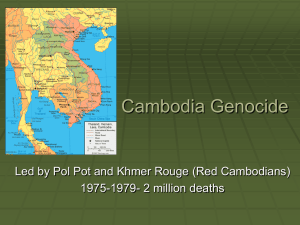
![Cambodian New Year - Rotha Chao [[.efolio.]]](http://s2.studylib.net/store/data/005298862_1-07ad9f61287c09b0b20401422ff2087a-300x300.png)

